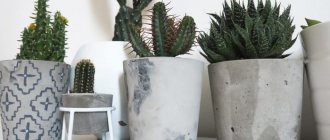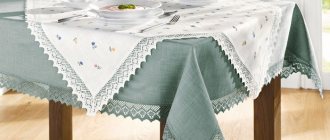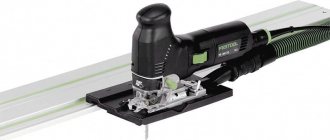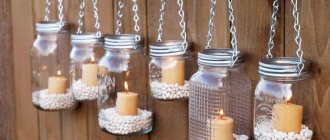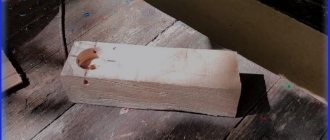What you need to make a flowerpot from cement and rags
To make garden planters from cement with your own hands, you need to prepare the following materials and tools:
- Cement. Portland cement M400 is used to create street decor.
- Rags. This could be unnecessary tulle, lace napkins, old waffle or terry towels, burlap. More interesting and original ones are made from cement planters using rags with a relief structure. The dimensions of the product can be both large and small, it all depends on desire and imagination, any rag can be used.
- Paint. For concrete surfaces, it will be possible to use acrylic, polymer, and water-based epoxy. Vinyl compositions, as well as acrylic-silicone and lime compositions, have worked well for decorating cement pots.
- Paint brushes.
- Low-density polyethylene film, packaging - stretch film.
- Form for pots. This can be a conical bucket or another suitable container of any geometric shape. The main thing is that there are no difficulties with the removal of the finished product.
- Container for mixing cement mortar.
- Protective gloves.
- Lubricant such as paraffin, vegetable oil, machine oil.
- Electric drill with mixer attachment.
Flowerpots made of cement and rags do not require special experience; anyone can do it.
Some recommendations for making flowerpots from cement and rags with your own hands:
- The working solution is prepared from cement (1 part), sand (2 parts), aggregate (4 parts) and water (½ part). Alternatively, you can do without additives, but if you want to make a real work of art, then you should add polymer components, natural minerals with dyes with fine fractions to the solution. Thanks to decorative concrete, the pots are interspersed with natural stones.
- Reinforcing frame if the structure is planned to be large in size.
- Sander. It is necessary to give the front side of the pots perfect smoothness. The first time they use an emery wheel, and then a felt wheel with a special paste.
Shape of hardened concrete towel
To create a product of an unusual configuration, any material that retains its original appearance for 5 hours is useful. After polymerization of the composition, the structure becomes stable. Thick cardboard, plastic products, plywood boards, and towels are often used to make molds.
The cement mixture for pouring should not be too liquid, so when preparing it it is better to achieve the consistency of thick sour cream. Cover the bucket with a towel and turn it over so that the concrete saturates the inside.
The length of the fabric blank should be adjusted before pouring the concrete. The towel is completely lowered into the bucket and soaked in the composition. When the task of saturating the fabric is completed, the towel is thrown over the bucket and left to dry. The average curing time is from 48 to 72 hours.
When working with cotton fabric, cement tile adhesive is used instead of concrete. It is recommended to choose quick-drying mixtures intended for outdoor use that are resistant to temperature changes.
The prepared rags are thoroughly moistened in the solution, wrung out and again immersed in cement. After impregnation, they are hung, draped on the body of the form, trying to give an interesting configuration. Beautiful texture is inherent in burlap products.
How to make a flowerpot from rags and cement
There are many variations of making unusual flowerpots from rags. You need to decide on the form and adhere to a certain algorithm of actions.
Simple planter made of cement and fabric
Master class on making cement pots:
- Cover the workpiece for future garden decor with plastic film. This material will facilitate easy release of the finished flowerpot.
- Prepare the working solution in a suitable container. First, clean water is poured into the container, and then cement is poured. For ease of mixing, it is recommended to use an electric drill with a mixer attachment. The consistency of the composition should resemble sour cream.
- Immerse a rag or burlap in the working solution. The material should be completely in liquid cement, it is advisable to leave it in it for 2-3 minutes.
- Stretch the rag over a bucket or any other container, straightening the edges. Imitation of folds on a flowerpot will look good. The time for the rag to dry completely is 3 days.
- Decorate the concrete decor from a rag with paint.
Planters made of gloves and cement
The step-by-step process of making original garden decor involves the following steps:
- Mix the working solution according to the instructions described in the previous case.
- Filling gloves with cement composition.
- Placement of workpieces for drying. They need to be laid so that they bend slightly, as if holding something.
- Removing gloves after the cement has hardened.
- Coloring pots as desired.
Video description
An example of making a flowerpot from a stocking and a tin can can be seen in the video:
Method 3 - sculptural
This method of making a flowerpot from cement is quite complex and requires artistic imagination and experience in sculpting and carving.
Experienced craftsmen use wet fine sand as the basis for creating the mold. It is poured into a suitable container, compacted thoroughly, and then the container is turned over onto a flat surface and removed. If you made sand cakes as a child, then you understand the technology. After the concrete has hardened, the sand can be easily removed from the flowerpot.
The resulting Easter cake is carefully doused with the solution and spread with a spatula over the entire surface. It is important to choose the correct thickness of the cement mixture. When this layer has set, prepare a thicker solution and begin decorating the walls. If you have no experience, you can start by simulating masonry, making lumps of different sizes from the mortar, gluing them to the walls and giving them shape. Then the excess mixture is selected between them, forming relief depressions - seams. When decorating, they are highlighted with color.
An example of a “stone” pots Source vkusnahka.ru
Useful tips
To achieve results when making flowerpots from cement and rags, you should adhere to the following tips:
- If there is a need to trim any of the edges of the flowerpot, you should use a large sanding mesh for drywall. A regular hacksaw is not an effective solution here; the edges will stand out too much from the general background.
- To decorate flowerpots made from old jeans, it is better to choose metallic acrylic paints. Bronze and greenery will look more advantageous.
- For ease of painting the finished product, white sand should be added to the working solution. Alternatively, you can cover it with plaster.
Video on creating flowerpots from cement and rags:
Small pots for cacti
It is difficult for beginners to start with volumetric structures. Some people may not be able to pour the solution into the container at all.
Then you can use the following instructions:
- Buy some cheap glass glasses. These can be found at IKEA, for example, “Darroka” for 29 rubles. a piece.
- Dilute the cement mortar in a plastic container. The glass should fit freely into it, with the top down. There is no need to add filler, just like sand. All you need is cement powder and water.
- Paint the glass with white paint. It is recommended to purchase a spray can; when sprayed, the paint adheres better to the glass. You can choose another paint. The main thing is that the glass ceases to be transparent.
- After waiting for the paint to dry, dip the glass in the newly diluted cement mortar. Allow the product to dry overnight.
Color can be added to cement to give it a specific color. It is recommended to use natural shades.
You may be interested in:
Really Useful Plastic Bottle Craft Ideas Since the late 1970s, plastic cans and bottles have become widely used as packaging materials for...Read more...
Spectacular examples
The collection of design finds contains many different beautiful ideas and spectacular examples. Delicate natures will not remain indifferent to a flowerpot in the shape of open palms. The technique is as follows: latex gloves are filled with a solution, and until they harden, they are given the shape of hands carefully holding delicate flowers.
Hungarian technology has found its fans. Its essence is that the role of forms is played by plywood templates with a semicircular recess and loops on the side made of wire.
The sequence of steps is as follows:
In the center of a sheet of plywood (or roofing felt), pour a mixture of sand and cement, mix everything, form a slide; We create a hole in it, where we carefully add water. We immerse a metal rod with loops from the template described at the beginning (we will create the internal walls). We rotate the rod like potters: a hemisphere comes out of the mixture
We put the film on top, again a layer of the mixture, then a metal mesh, and more solution on it. The final stage is to use the second template. It will “support” the outer walls of the product. And the result will be a kind of openwork fantasy structure, completely different from heavy cement monuments. All that remains is to remove the rod and leave the product to dry.
If the appearance of the flowerpot seems faded to you, designers advise decorating it. Bright acrylic painting looks impressive. Concrete is easy to paint. You just need to thoroughly prime the surface before painting, but do not overdo it with the palette. The decorations on the flowerpot should not, in terms of color, prevail over the natural flowers that you are going to grow in this container.
The unexpected effect of the iridescent multi-colored surface of the flowerpot is achieved by mosaic finishing. Pieces of broken ceramic tiles can be used as mosaics. The tile fragments are laid after the surface of the concrete product is covered with a thick layer of special glue (a layer of 5-6 cm). The tile is pressed into it.
The same method is suitable for decorating a flower container with pebbles. Only here you have to be careful, immediately remove traces of glue from the stones, otherwise you won’t be able to remove it later. To make it more elegant, the gaps between the decorative fragments are rubbed after the glue has dried. Flowerpots with mosaics, paintings in Byzantine or Indian style look beautiful.
Even a non-professional can make flowerpots from concrete. The main thing is to study the step-by-step instructions and follow their recommendations. Concrete bowls look beautiful when decorated with paintings or stones. Thanks to your imagination, you get an exclusive and durable container in which you can grow flowers every year.
How to make concrete flowerpots with your own hands, see below.
Square pots with gilding
Typically, concrete pots are left uncovered: this makes them look more authentic. But why not play with their appearance? With the help of simple paint, faceless gray concrete can be turned into a decoration not only for minimalist interiors, but also for rooms in the Empire style, ethnic style, and so on.
The manufacturing process is similar to that which has already been described many times above. Square pots are best suited for painting. They are easy to use stencils on. After the cube pot is ready, you need to:
- Wait at least 4 hours for the concrete to set. Remove from the mold.
- Cover with white paint. If you choose a paint with the addition of fine sand, it will help hide minor surface irregularities. In this case, you will be able to do without thorough sanding, but before applying the substance, it is still recommended to go through the corners with a file.
- When the first coat of paint has dried, apply a second coat if necessary. This may be necessary if the paint is translucent and the gray base shows through.
- Wait for the paint to dry. The drying speed and time required to apply the second coat are indicated on the packaging. Usually it is 12 hours.
- Cut out a stencil from cardboard. You can repeat the pattern in the photo or use your own sketch. Using metallic paint in a gold or bronze shade, apply the design through a stencil.
Such a pot will delight the eye for a long time and is suitable not only for strict men’s interiors, but also for elegant women’s bedrooms.
Advice!
Since concrete is porous, it is best to use a thin layer of primer before applying paint. This way the paint will adhere better, and you won’t have to renew it in a couple of years.
You may be interested in:
How to decorate and illuminate garden paths in an original way? With the onset of the spring-summer season, summer residents clean up their garden plots. They plant flowers and trees,...Read more...
Preparation of the solution
In order for the flowerpot to be beautiful and of high quality, it is necessary to make the right solution, then the product will have the required density and will also harden quickly.
To prepare the solution, use white Portland cement, gravel, the fraction of which is up to 7 millimeters, and fine sand. In the prepared container, mix all the components, 2 portions of sand, one portion of cement, and gravel. Water is added gradually to the required viscosity. To make the pots light, you can add small expanded clay; they can replace a portion of gravel. The molds are poured and covered with oilcloth or a damp cloth, while the material hardens slowly, this will help prevent cracks from appearing on the surface. After four days, you can disassemble the constructed structure, trim all the irregularities, and sand it with sandpaper. You can make a solution that, after drying, resembles sandstone; for this, take part of the cement, sand, and two portions of peat, and then dilute it with water to a thick mass. The required shape is molded from the resulting mass.
Let's sum it up
Instead of buying expensive flower pots, you can easily make your own. This work does not require special precision, skills, or equipment. An old bucket or pot found in the attic can start a new life as an unusual flowerpot. Concrete pots look good in the garden and are durable. Homemade flower pots can be imperfect, and that's the beauty of them. Plants grow well in them and look harmonious in modern gardens. Their small size fits into some modern styles.
Caring for concrete pots is as easy as caring for plastic pots - just wash with water. Homemade pots are not only an easy way to create a functional, original decoration, but also a lot of fun from the work done!
Sources:
https://salecement.ru/kak-sdelat-kashpo-iz-cementa-i-tkani-i-chto-dlya-etogo-nuzhno/ https://vdome.club/podelki/raznoe/kashpo-iz-tsementa- svoimi-rukami-master-klass-s-foto.html https://1beton.info/izdeliya/kak-sdelat-kashpo-iz-tsementa-i-tryapok-tkani-svoimi-rukami-poshagovoe-rukovodstvo https:// wiki-dacha.ru/gorshki-dlya-tsvetov-iz-cementa
An easy way to create original jewelry
Spring has come, it's time to plant flowers in balcony boxes and flowerpots. Good large flowerpots are expensive, they are heavy, and do not always meet our expectations in size, shape, and color. Lighter pots are fragile and not resistant to frost. An interesting alternative to purchased flowerpots are homemade pots made from concrete using various shapes and decorative methods.
It is important to choose the right size of pots. The dimensions depend on the dimensions of the form used.
- The wall thickness of a large container should be about 5 cm to ensure strength;
- for a small pot, a thickness of 1 cm is sufficient;
- for a large container with a width and height exceeding 50 cm, the minimum thickness is 7-8 cm.
Planter under a wooden bucket
It’s not hard to figure out how to make such a pot: just use an old wooden bucket as a mold. You can put together something similar yourself. After the concrete has set, it needs to be decorated. Wood grains will not appear immediately; they need to be created using a cutter. The overlay imitating a metal ring will also have to be applied separately. Finally, holes are made in the concrete for the rope.
It's a bit heavy to carry 10 and 20 kg pots. To make the structure lightweight, foam should be used as a second filler. This tip can be applied to any design.
Decorating flowerpots
For minimalist arrangements in a modern loft style, raw concrete pots without decoration or paint are suitable. To create romantic, rural, retro gardens, you can decorate ready-made flower pots in various ways.
- When the material is completely dry and hardened, you can paint the product. The finished pot can be painted with special durable paints for plaster or decorated with aerosol paints and varnished.
- You can add interesting texture to fabric and cement pots using tile adhesive. If you choose a high-quality frost-resistant composition, you can leave the pot outside in winter.
- An interesting option is to glue decor to the pots:
- shells;
- pebbles;
- pieces of glass;
- broken tiles.
Preparing the template
It was already mentioned above that such work will require forms. They can be containers made of wood, clay, metal, plastic, glass, plywood. The main thing is that they do not crack and last at least 4 hours. Then the filling will harden and will be able to hold its shape on its own.
To strengthen the shape, you can cover the cardboard form with tape and additionally glue the corners. But in this case the flowerpot will turn out to be small.
Concrete products can be easily removed from plastic molds. As for glass ones, if the decor sticks, they can be broken. An additional form will have to be placed inside the future vase to create a recess for plants.
The illustration for the article is taken from open sources
Make it taking into account the following requirements:
- wall thickness – at least 3 mm;
- size – less than the circumference of the vase;
- the figure is correct if possible.
Ceramic dishes for flowers
An ordinary ceramic vase, deep dish, or bowl can make wonderful flower pots. It is better to choose old dishes with traces of chips and cracks for decoration.
- Large cracks can be treated with silicone glue. We should not forget about the drainage holes that are drilled in the bottom of the prepared container.
- The outer surface of the dishes can be coated with paint and wrapped with a textured cord attached to glue.
- Very often, craftsmen resort to using eggshells, the fragments of which are used to cover the walls of the vase.
